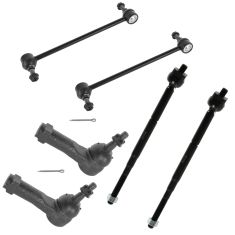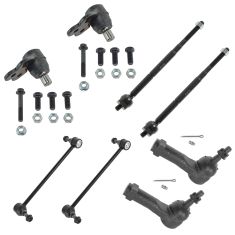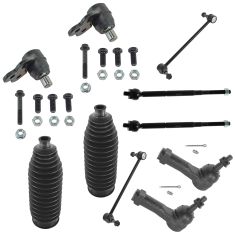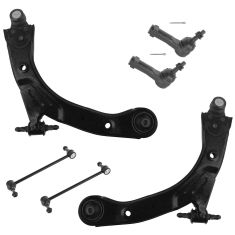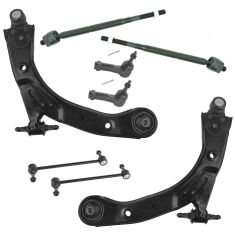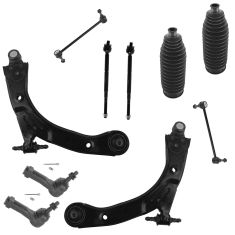1ASFK00248-Chevrolet Pontiac Saturn Front Driver & Passenger Side 2 Piece Sway Bar Link Set TRQ PSA55627
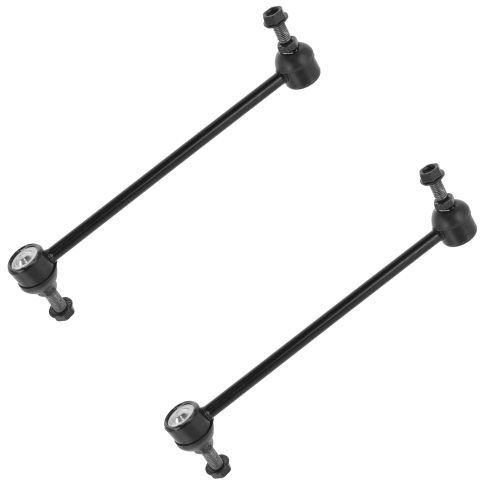
Replaces
2005 Saturn Ion with 300mm Front Sway Bar Links Front Driver & Passenger Side 2 Piece Sway Bar Link Set TRQ PSA55627

Product Reviews
Loading reviews
4.91/ 5.0
22
22 reviews
Very pleased solve my problem
January 25, 2017
It was harder to get the old ones out than anticipated because of tight spaces and my inexperience but got the job done. I was very pleased with how quiet the car was going over bumps. Before it made a rattling noise even over a crack in the pavement. This solved it and it feels great that I fixed it myself with minimal tools.
Sway bar links
March 19, 2018
I really love the ride my sway bar links have done for my car, and the price was absolutely fair, but I do have a question, are they needed for the back of the car as well
March 31, 2018
Build quality is good. Very comparable to Moog parts and quality for significantly cheaper.
2008 g6 pontiac sway bar links.
July 15, 2018
I ordered the sway bar links for my wife's 2008 g6 Pontiac. I watched the 1a auto video on installation & it helped greatly. These new links cured the popping noise in the front end. The car was as quiet as New. I would highly recommend 1a auto. Terry G.
Sway bar link pair for 2010 G6
July 22, 2018
Overall these were a perfect match to replace they old ones. I had a noise coming from the driver's side tire area every time I drive over a bump. These fixed the problem. I really liked the fact that 1A Auto has how to videos associated with their products. I would have given this item 5 stars but I'm some what concerned on how these were made. They have 2 spot welds holding the ball joint area to the shaft. The original factory links are a one piece design. No spot welds. I have been driving with the new links for about 1000 miles with no issues. The car handles much better too. And I saved money so I feel I made a good decision buying these from 1A Auto.
Great buy
July 31, 2018
Product replaced old and fit very well. Easy to remove old and replace with new. Saved me at least 80 bucks compared to buying local at auto store. Will continue to shop here for future parts.
Auto parts order review
August 18, 2018
Very please With the auto parts , they were exactly what I ordered. I was very pleased with the shipping time as well as the ease of ordering these parts. Will plan to use this company again as I need it for parts. I would highly recommend as a supplier for your car parts if available through them.
Awesome
September 26, 2018
Bought many Many parts, great quality fast shipping and awesome prices as always. Will keep buying from them
Sway bar links
September 29, 2018
Every part that you can think of i can find at 1A auto the sway bar links fit like they should. Go 1A Auto
God purchaee
October 23, 2018
I liked the fast and free shipping . The part went on like it should seems to be a good product. I recommend A-1
Links
November 21, 2018
The quality of these parts exceeded OEM in my opinion. Simplicity to install pain in the butt to remove OEM
Great parts
December 27, 2018
They parts work for what we needed. They were good on shipping and fast to answer questions.
Great Quality
January 1, 2019
They make it easy for us who want to fix our own cars. Fast shipping, great prices and quality!
SWAY BAR LINKS 08' PONTIAC GS
May 9, 2019
GREAT PRODUCT WAS EASY TO INSTALL AND FOT PERFECTLY
Great parts
June 21, 2019
The parts ordered were shipped on time and fit my son's car great.
Good price
September 13, 2020
Installed easily and seemed to be a lot better quality than oreilly sway bar links
Stabilizer link
February 28, 2021
Parts came quick. They were accurate and fast.
Ordering was easy and completed with no problems.
Quality looking OEM replacement
May 14, 2021
Sway bar links that are a direct replacement for your rusty or broken links on your car.
August 8, 2022
Perfect fit
Sway bar links for my Malibu
December 30, 2022
Units appeared to be of good quality and were fairly easy to install. They solved the clunking issue int he front end, especially on uneven roads at over 100 mph.
November 9, 2023
Parts were as expected, they went on without any problems and are working great.
January 31, 2024
Parts arrived quickly and fit as promised!
Customer Q&A
Do I have to buy bushings for these sway bars or are they included?
March 17, 2019
10
You do not. These actually seemed to be a better design than the stock set I removed off my g6
March 17, 2019
B W
10
The bushings will be included in this kit.
March 17, 2019
Emma F
10
No. From the picture.
They are like tie rods.
Drive old out. Put new one in
March 17, 2019
Joseph S
Whats the size of the front sway bar link?
December 28, 2020
10
Actual Measurements are not listed or available. Our parts are exact replacements for your vehicle's OEM parts. As long as your year, make, and model match up with our listing, these parts will directly fit and function like the originals.
December 29, 2020
Christa R
Saturn is a registered trademark of General Motors Company. 1A Auto is not affiliated with or sponsored by Saturn or General Motors Company.
See all trademarks.









